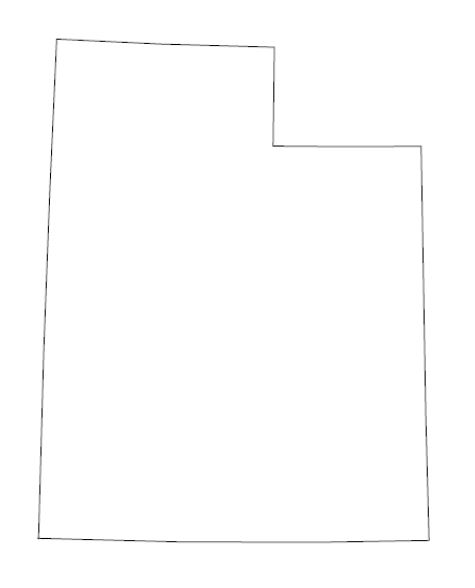Utah, located in the western United States, is known for its diverse geography and unique landscape. The state is bordered by Nevada, Idaho, Wyoming, Colorado, and Arizona, and is comprised of a total area of 84,899 square miles. Utah is often referred to as the “Beehive State” due to its emblematic symbol, which represents hard work and industry.
Utah Outline Map

Click Here to Download
An outline map of Utah is a visual representation of the state’s geographical borders and geographic features, such as rivers, lakes, and mountain ranges. It serves as a useful tool for students, teachers, and anyone interested in the geography of Utah. The outline map typically depicts the state’s borders in black or blue, while leaving the interior of the state blank or white. This allows the viewer to focus on the state’s borders, while still having a general idea of the state’s geographic features.
A blank map of Utah is similar to an outline map in that it depicts the state’s borders, but with no additional information about geographic features or location markers. This type of map is often used for educational purposes, such as for students to fill in geographic features or important locations, or for individuals to practice mapping skills. The blank map is a blank canvas, allowing the user to add their own information and tailor the map to their specific needs.
Utah’s diverse geography is one of its defining characteristics. The state is home to several mountain ranges, including the Wasatch Mountains, the Uinta Mountains, and the Tushar Mountains, as well as several plateaus, such as the Great Basin Plateau and the Colorado Plateau. The state is also home to several deserts, including the Great Salt Lake Desert, the Sevier Desert, and the Escalante Desert.
In addition to its unique landscape, Utah is also home to several important rivers and lakes. The Green River and the Colorado River both flow through the state, while the Great Salt Lake is the largest saltwater lake in the western hemisphere. These geographical features not only play an important role in the state’s ecology, but also provide valuable resources for the state’s residents, including irrigation and recreation.
Utah’s geography has played a crucial role in its history and development. The state’s deserts and mountains have served as a barrier to westward expansion, while its rivers have provided valuable resources for early settlers. The state’s rich natural resources, including coal, oil, and minerals, have attracted many industries to the state, which has helped drive its economic growth and development.
In conclusion, an outline map and blank map of Utah are important tools for understanding the state’s geography. The outline map provides a visual representation of the state’s borders and geographic features, while the blank map allows users to add their own information and tailor the map to their specific needs. Utah’s diverse geography, including its mountain ranges, plateaus, deserts, rivers, and lakes, plays an important role in the state’s ecology, history, and development. Understanding Utah’s geography is essential for anyone interested in this unique and beautiful state.


